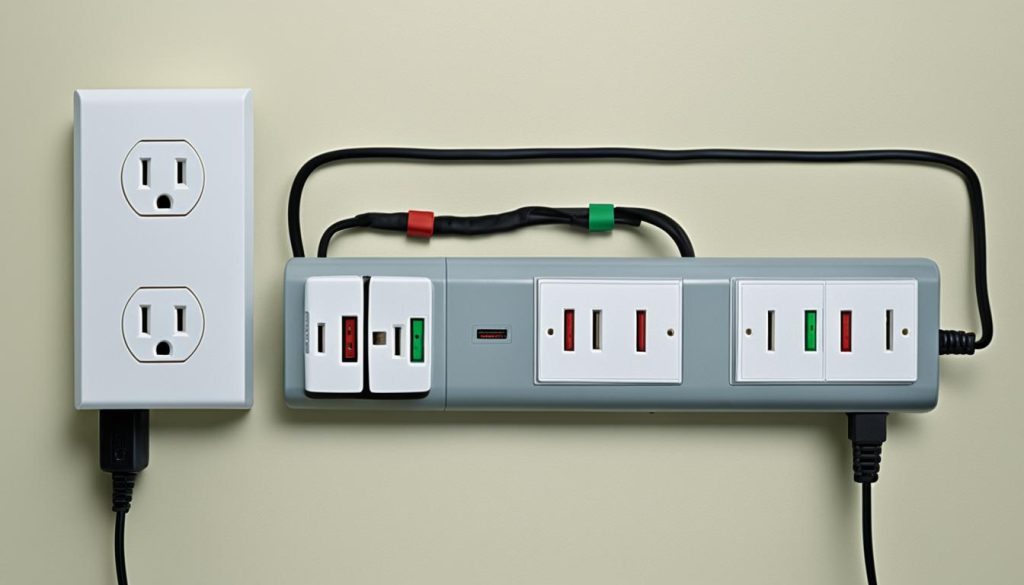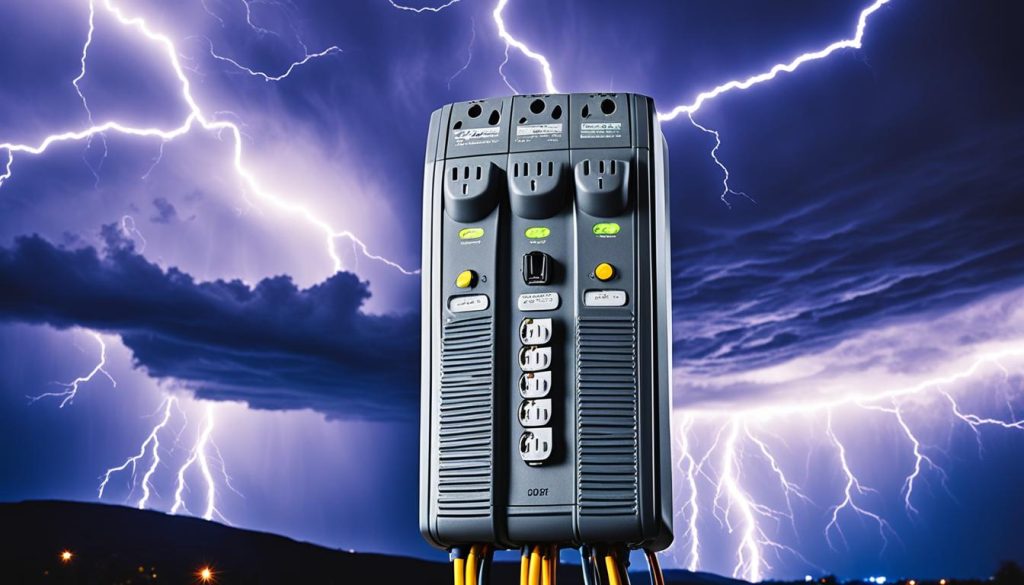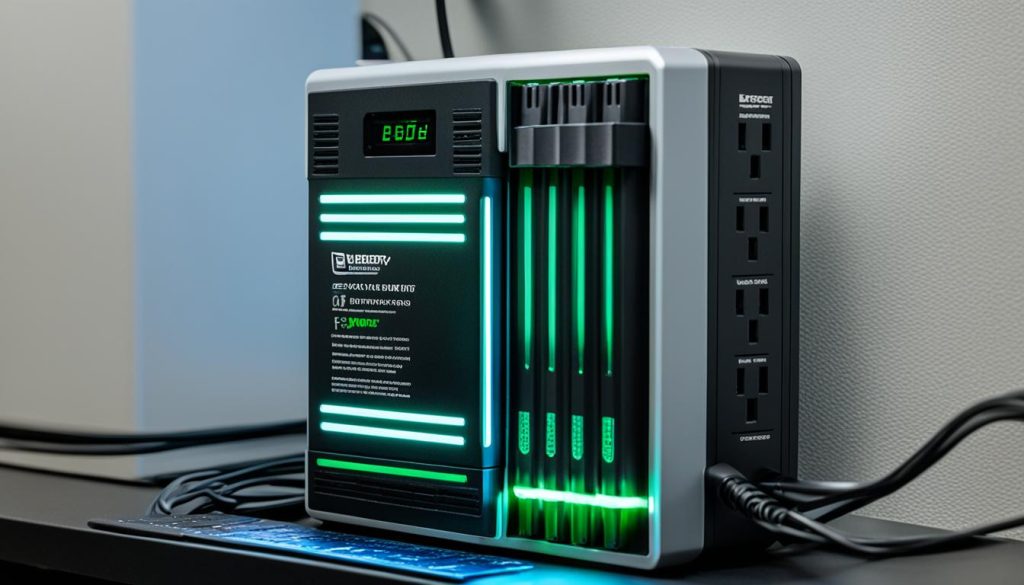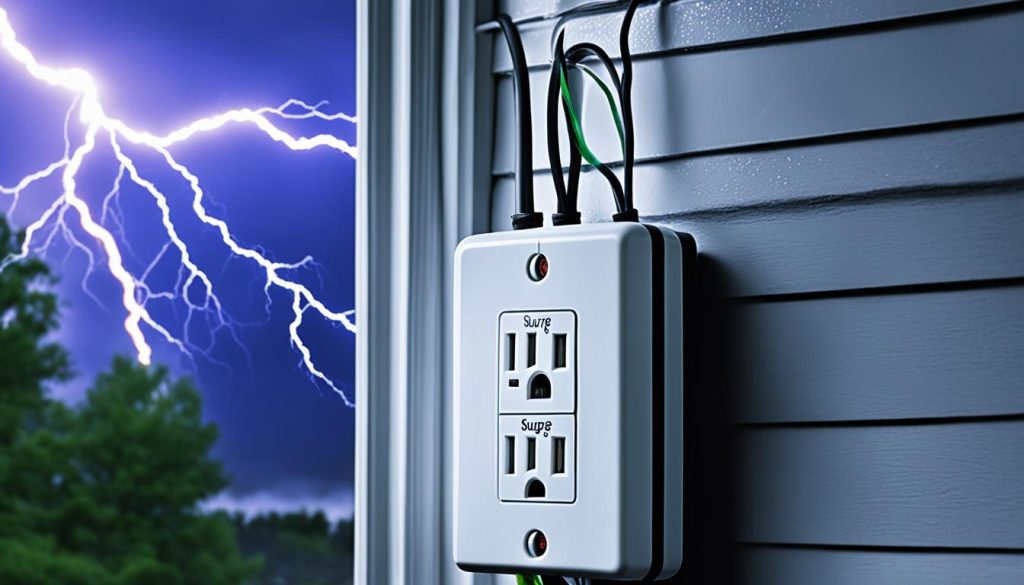When it comes to protecting your electronic devices and ensuring electrical safety, it’s important to understand the difference between power strips and surge protectors. Power strips and surge protectors are both useful devices, but they serve different purposes.
A power strip is a device that provides multiple outlets for powering devices. It is convenient for plugging in multiple devices at once and often comes with energy-saving features. However, power strips do not offer protection from power surges, which can be detrimental to your electronics.
A surge protector, on the other hand, is specifically designed to protect your electronic devices from power surges. Power surges occur when there is an increase in electrical charge in power lines, often caused by lightning strikes or voltage spikes. These surges can damage or even destroy your expensive electronics.
Surge protectors come in different forms, including wall mount options and plug-in options. They have components such as spike suppressors and surge protection devices that absorb and block power surges. Surge protectors are essential for safeguarding sensitive electronics, such as computers and TVs, from potential damage.
Key Takeaways
- Power strips provide multiple outlets for devices but do not offer surge protection.
- Surge protectors are designed to protect electronics from power surges caused by voltage spikes or lightning strikes.
- Surge protectors have components that absorb and block power surges, ensuring the safety of your electronics.
- Using surge protectors is crucial for protecting sensitive electronics from potential damage.
- Consider the absorption rating and clamping voltage when purchasing surge protectors to ensure effective protection.
What is a Power Strip?
A power strip is a versatile device that provides multiple outlets for powering various devices simultaneously. It is an essential tool for anyone who needs to plug in multiple devices in one central location. Power strips are commonly used in homes, offices, and other workspaces where there is a need for multiple power sources.
One of the advantages of using a power strip is its energy-saving features. Many power strips come equipped with built-in timers or smart technology that automatically powers off outlets when devices are on standby mode or not in use. This feature helps conserve energy and reduce utility costs.
With a power strip, you can conveniently connect multiple devices such as laptops, smartphones, tablets, printers, and gaming consoles all at once. It eliminates the hassle of constantly switching between different outlets and allows for efficient power management. Additionally, power strips typically come with surge protection, safeguarding your devices against power spikes and electrical surges.
Here’s an image that demonstrates the functionality of a power strip:
What is a Surge Protector?
A surge protector is a vital device designed to safeguard your electronic devices from damaging power surges. Power surges occur when there is a sudden increase in voltage in the power lines, often caused by lightning strikes, faulty wiring, or power grid fluctuations. Surge protectors come in various forms, including wall mount options and plug-in options, making them suitable for different applications.
The Components of a Surge Protector
A surge protector contains several key components that work together to provide effective surge protection:
- Spike suppressors: These components are designed to absorb high-voltage spikes that occur during a power surge, diverting them away from your electronic devices.
- Surge protection devices: These devices actively monitor the incoming electrical power and, when a surge is detected, redirect the excess voltage away from your devices.
Surge protectors are also available with additional features, such as built-in USB ports, Ethernet protection, and coaxial cable protection, providing comprehensive protection for a wide range of devices and connections.
Types of Surge Protectors
Surge protectors are designed to cater to different needs and applications:
- Whole-house surge protectors: These surge protectors are installed at the electric meter or main breaker panel, safeguarding your entire home from power surges.
- Outlet surge protectors: These plug directly into standard electrical outlets, offering surge protection for individual devices or small groups of devices.
- Specialized surge protectors: Some surge protectors are specifically designed for phone lines, coaxial cables, or other specialized connections, ensuring comprehensive protection for your entire setup.
No matter the type, surge protectors play a critical role in preventing costly damage to your sensitive electronic devices, including computers, TVs, gaming consoles, and smart home systems.
Investing in a surge protector is a wise decision that can potentially save you from expensive repairs or replacements due to power surges.
Surge Protector vs. Power Strip
When it comes to protecting your electronic devices from voltage spikes and lightning strikes, it’s important to understand the key differences between surge protectors and power strips. While both devices provide multiple outlets for powering your devices, only surge protectors offer the additional benefit of safeguarding against power surges.
Not all power strips have surge protection built-in, so it’s important to choose a device that specifically incorporates surge protection features. Surge protectors are designed to detect and divert excess voltage away from your devices, protecting them from potential damage caused by voltage spikes or lightning strikes.
Surge protectors are equipped with advanced components such as spike suppressors and surge protection devices, which are essential for absorbing and blocking power surges. These devices act as a barrier between your electronic devices and the electrical fluctuations that can occur due to voltage spikes or lightning strikes.
While power strips are convenient for distributing power to multiple devices, they do not provide the same level of protection as surge protectors. In the event of a power surge, surge protectors offer a crucial layer of defense, preventing sudden power loss that can potentially lead to irreversible damage to your electronics.
To illustrate the differences between surge protectors and power strips, refer to the table below:
| Feature | Power Strip | Surge Protector |
|---|---|---|
| Provides multiple outlets | ✓ | ✓ |
| Protects against voltage spikes | X | ✓ |
| Protects against lightning strikes | X | ✓ |
| Prevents sudden power loss | X | ✓ |
As you can see from the table, surge protectors offer a comprehensive solution for safeguarding your electronics from the risks associated with power surges caused by voltage spikes and lightning strikes. While power strips are useful for providing additional outlets, it is crucial to invest in a surge protector to ensure the long-term protection of your valuable devices.

When it comes to protecting your electronic devices, don’t leave their safety up to chance. Choose a surge protector that suits your needs and provides the necessary protection against voltage spikes and lightning strikes.
Which is Better, Power Strip or Surge Protector?
When it comes to protecting your electronic devices, both power strips and surge protectors serve important roles. However, if you prioritize long-term use and maximum protection, surge protectors are the superior choice. Surge protectors are specifically designed to safeguard your equipment against power surges, offering an extra layer of defense that power strips lack.
While power strips provide multiple outlets for powering devices, surge protectors go a step further by actively shielding your valuable electronics from sudden power fluctuations. Investing in a surge protector is well worth the slightly higher cost, as it ensures the longevity of your devices and prevents costly damages.
To enjoy the best of both worlds, it is advisable to choose a power strip that includes surge protection. This way, you can power multiple devices simultaneously while providing them with the necessary protection against electrical surges. By selecting a power strip with built-in surge protection, you can enjoy the convenience and versatility of multiple outlets without compromising on safety.
Remember, electronic devices are vulnerable to power surges, which can be caused by lightning strikes, voltage spikes, or other electrical disturbances. To protect your equipment and ensure its long-term use, investing in a surge protector is the smart choice.

| Power Strip | Surge Protector |
|---|---|
| Provides multiple outlets | Offers multiple outlets with surge protection |
| No active protection against power surges | Specifically designed to safeguard against power surges |
| May lead to device damage during power surges | Prevents device damage during power surges |
| Cost-effective for basic electrical needs | Provides long-term protection for valuable electronics |
Surge Protector vs. UPS
When it comes to protecting your electronic devices, the choice between a surge protector and an uninterruptible power supply (UPS) depends on your specific needs. While both provide essential power management features, they serve different purposes.
A surge protector is designed to safeguard your devices from power surges caused by voltage spikes or lightning strikes. It acts as a barrier between the power source and your equipment, diverting excess voltage away from your devices. Surge protectors are essential for preventing damage to sensitive electronics, such as computers, televisions, and gaming consoles.
“A surge protector is like a shield, protecting your devices from harmful power fluctuations and ensuring their longevity.”
On the other hand, a UPS offers more than just surge protection. It provides temporary power backup during blackouts or power outages, ensuring uninterrupted operation of your devices. UPS devices use batteries or other power sources to supply immediate power when the main power supply fails, allowing you to save your work, safely shut down your equipment, or continue working without any interruption.
If you rely on continuous power for critical devices, such as servers, networking equipment, or desktop computers, a UPS is an essential investment. It not only protects your equipment from power surges but also provides temporary power backup, giving you peace of mind during unexpected power outages.
Here’s a quick comparison to help you understand the key differences between surge protectors and UPS:
| Surge Protector | UPS |
|---|---|
| Protects against power surges | Protects against power surges |
| Does not provide backup power | Provides temporary power backup |
| Safeguards sensitive electronics | Ideal for devices requiring continuous power |
| Less expensive than UPS | Relatively more expensive |

Ultimately, the choice between a surge protector and a UPS depends on your specific needs and the level of protection and power backup required for your devices. If you want to safeguard your electronics from power surges, a surge protector is a must-have. However, if you require temporary power backup during outages, a UPS is the ideal solution.
Choosing the Right Power Protection Solution
Consider the following factors when selecting the appropriate power protection solution:
- The sensitivity of your electronics
- The risk of power surges in your area
- The importance of continuous power for your devices
- Your budget and power requirements
By carefully considering these factors, you can make an informed decision and ensure the safety and reliability of your electronic devices.
When to Use a Surge Protector
Protecting your sensitive electronics from power surges is crucial in maintaining their longevity and functionality. Microprocessors, which are present in computers and other devices, are particularly vulnerable to damage caused by power surges. To ensure the safety of your valuable electronics, it is essential to use a surge protector.
Surge protectors are designed to absorb and divert excess voltage, safeguarding your devices from the harmful effects of power surges. They act as a defense mechanism, protecting sensitive microprocessors and other components from being overloaded with excessive electrical charge.
Surge protectors are especially necessary in situations where there is a higher risk of power surges. Thunderstorms, for instance, can cause sudden spikes in electrical current, posing a significant threat to your electronics. Using a surge protector during these weather conditions can provide you with peace of mind, knowing that your devices are well-protected.
Additionally, surge protectors are essential when using devices that have high power demands. Appliances like refrigerators, air conditioners, or home theater systems can generate power surges within your electrical system. Utilizing a surge protector in these scenarios can help prevent any potential damage and ensure the uninterrupted functioning of your electronics.
By using a surge protector, you are taking proactive steps to safeguard your sensitive electronics and prevent costly damages. It is a simple yet effective measure that can extend the lifespan of your devices and provide you with a worry-free experience.
Key Benefits of Using a Surge Protector:
- Protects microprocessors and sensitive electronic components
- Defends against power surges caused by lightning strikes and voltage spikes
- Provides peace of mind during thunderstorms and weather-related events
- Ensures uninterrupted functioning of devices with high power demands
- Helps extend the lifespan of your electronics
| Power Surge Protection | Benefits |
|---|---|
| Protects microprocessors and sensitive electronics | Prevents damage and extends the lifespan of devices |
| Defends against power surges caused by lightning strikes and voltage spikes | Safeguards electronics from sudden electrical fluctuations |
| Provides peace of mind during thunderstorms and weather-related events | Reduces anxiety about potential damage to electronics |
| Ensures uninterrupted functioning of devices with high power demands | Prevents disruptions and preserves device functionality |
| Helps extend the lifespan of your electronics | Ensures long-term reliability and performance |
Investing in a surge protector is a wise decision for anyone who values the safety and longevity of their sensitive electronics. By using this simple yet effective device, you can protect your devices from power surges and ensure their optimal performance for years to come.

Tips for Using UPS and Surge Protectors
When it comes to using UPS and surge protectors, your safety should be a top priority. Follow these essential tips to ensure efficient power distribution and adequate protection for your valuable electronics.
Firstly, avoid plugging surge protectors into UPS outlets and vice versa. This simple step will help optimize power distribution and prevent any potential issues. Instead, use surge protectors for your electronic devices and reserve UPS outlets for devices that require temporary power backup during outages.
Consider the number of outlets you need when purchasing a UPS or surge protector. Evaluate the total number of devices you plan to connect and choose a device with enough outlets to accommodate them all. This will help you avoid the inconvenience of using additional power strips or adapters.
When buying surge protectors, pay attention to the absorption rating and clamping voltage. The absorption rating indicates the maximum amount of energy the surge protector can absorb before it needs replacement. Higher absorption ratings offer better protection for your electronics. Clamping voltage, on the other hand, refers to the point at which the surge protector begins to divert excess voltage. Look for surge protectors with lower clamping voltages, as they provide more effective protection.
Lastly, remember to regularly replace surge protectors every three to five years. Over time, the components in surge protectors degrade, reducing their effectiveness. By replacing them at regular intervals, you can ensure that your electronics remain adequately protected against power surges.
FAQ
Are power strips surge protectors?
No, power strips and surge protectors are different devices. While power strips provide multiple outlets for devices, surge protectors offer additional protection from power surges.
What is a power strip?
A power strip is a device that provides multiple outlets for powering devices. It often has energy-saving features and can power off outlets when devices are on standby mode. Power strips are a convenient and safe option for powering multiple devices at once.
What is a surge protector?
A surge protector is a device designed to protect electronic devices from power surges. It comes in different forms and has components such as spike suppressors and surge protection devices to absorb and block power surges.
What is the difference between a power strip and a surge protector?
Power strips provide multiple outlets for devices but do not offer protection from power surges. Surge protectors, on the other hand, are specifically designed to protect against power surges caused by voltage spikes or lightning strikes.
Which is better, a power strip or a surge protector?
Surge protectors offer better long-term protection for electronics as they are specifically designed to safeguard against power surges. While power strips distribute voltage to multiple devices, surge protectors provide the added benefit of protecting electronics from sudden power loss due to power surges.
What is the difference between a surge protector and a UPS?
While surge protectors protect against power surges, uninterruptible power supplies (UPS) provide temporary power backup during power outages. UPS devices use batteries or other power sources to supply immediate power to devices when the main power supply fails.
When should I use a surge protector?
It is recommended to use surge protectors to safeguard expensive electronics from power surges. Microprocessors in computers and other electronics are sensitive and can be damaged without surge protection. Surge protectors are particularly important when there is a risk of power surges, such as during thunderstorms or when using devices with high power demands.
What are some tips for using UPS and surge protectors?
When using UPS and surge protectors, avoid plugging surge protectors into UPS outlets and vice versa to ensure efficient power distribution. Consider the number of outlets needed when purchasing a UPS or surge protector. Additionally, check for absorption rating and clamping voltage when buying surge protectors to ensure adequate protection for your electronics. Regularly replace surge protectors every three to five years to maintain their effectiveness.


